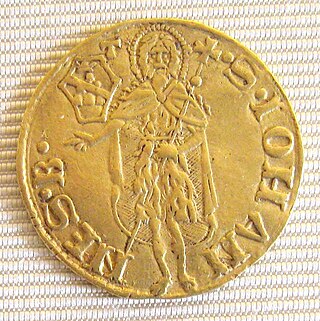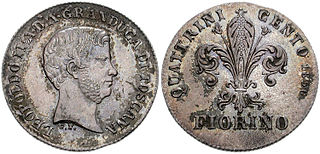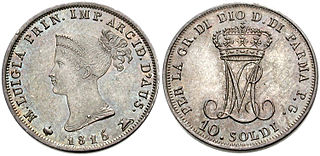
The Genoese lira (Italian : Lira genovese) was the currency of the Republic of Genoa until 1797.

The Genoese lira (Italian : Lira genovese) was the currency of the Republic of Genoa until 1797.
The mint in the Republic of Genoa began its production around 1138, [1] with coins introduced in line with similar versions issued in the rest of Europe, as follows: [2]
Genoese currency became important in the 16th century during the Golden age of Genoese banking, with the Spanish Empire funnelling its massive wealth from Spanish America through the Bank of Saint George. Genoa then introduced new coins, namely: [4]
With the decline in the fortunes of the Genoese banks and the Spanish Empire in the 17th century, however, the Genoese lira also depreciated substantially. The silver scudo's value increased to 6.5 lire in 1646, 7.4 lire in 1671, and 8.74 lire just before the Austrian occupation of Genoa in 1746. [5]
The lira in existence from the 12th century was later called the lira moneta buona (good money) or lira fuori banco (outside the bank) to disambiguate from the huge array of auxiliary units used by Genoa's banking industry to account for various currencies brought there over the centuries. [6] Each lira or unit below also divided into 20 soldi or 240 denari; the various units are as follows: [7]
After the 1746 siege the Genoese lira was devalued with the scudo d'argento rising from 8.74 to 9.5 lire (or 3.86 g fine silver in a lira). When the period of the Republic ended in 1797, the one lira coin weighed 4.16 g at 8/9 fine, equal to 3.70 g fine silver or 0.239 g fine gold. [8]
From 1797 the Genoese lira and all its auxiliary units were replaced by the French franc, and afterwards the Italian lira. However, the Mint of Genoa remained in operation by issuing coins until 1860. [8]

The Florentine florin was a gold coin struck from 1252 to 1533 with no significant change in its design or metal content standard during that time. It had 54 grains of nominally pure or 'fine' gold with a purchasing power difficult to estimate but ranging according to social grouping and perspective from approximately 140 to 1,000 modern US dollars. The name of the coin comes from the Giglio bottonato, the floral emblem of the city, which is represented at the head of the coin.

The ducat coin was used as a trade coin in Europe from the later Middle Ages to the 19th century. Its most familiar version, the gold ducat or sequin containing around 3.5 grams of 98.6% fine gold, originated in Venice in 1284 and gained wide international acceptance over the centuries. Similarly named silver ducatons also existed. The gold ducat circulated along with the Florentine florin and preceded the modern British pound sterling.

The lira was the currency of Italy between 1861 and 2002. It was introduced by the Napoleonic Kingdom of Italy in 1807 at par with the French franc, and was subsequently adopted by the different states that would eventually form the Kingdom of Italy in 1861. It was subdivided into 100 centesimi, which means "hundredths" or "cents". The lira was also the currency of the Albanian Kingdom from 1941 to 1943.

The scudo was the name for a number of coins used in various states in the Italian peninsula until the 19th century. The name, like that of the French écu and the Spanish and Portuguese escudo, was derived from the Latin scutum ("shield"). From the 16th century, the name was used in Italy for large silver coins. Sizes varied depending on the issuing country.

The lira was the currency of the Kingdom of Sardinia between August 6, 1816, and March 17, 1861.
The lira austriaca was the currency of the Kingdom of Lombardy–Venetia.

The Tuscan fiorino was the currency of Tuscany between 1826 and 1859. It was subdivided into 100 quattrini, a local currency made by four denari. There was an additional denomination called the paolo, worth 40 quattrini, in circulation.

The lira was the currency of the Grand Duchy of Tuscany until its annexation by Napoleonic France in 1807. After that year, it unofficially remained in circulation thanks to its silver value until the restoration of Tuscan independence in 1814. It was finally abolished in 1826.

The Roman scudo was the currency of the Papal States until 1866. It was subdivided into 100 baiocchi, each of 5 quattrini. Other denominations included the grosso of 5 baiocchi, the carlino of 7+1⁄2 baiocchi, the giulio and paoli; both of 10 baiocchi, the testone of 30 baiocchi and the doppia of 3 scudi.

The lira was the currency of the Papal States between 1866 and 1870. It was subdivided into 20 soldi, each of 5 centesimi.
The lira was the distinct currency of Venice until 1848, when it was replaced by the Italian lira. It originated from the Carolingian monetary system used in much of Western Europe since the 8th century CE, with the lira subdivided into 20 soldi, each of 12 denari.
The scudo was the currency of Milan until 1806. It was subdivided into 6 lire, each of 20 soldi or 240 denari.
The lira was the currency of the Republic of Lucca until 1800 and again of the Duchy of Lucca between 1826 and 1847. It was subdivided into 20 soldi, each of 3 quattrini or 12 denari.

The lira was the distinct currency of Parma before 1802 and again from 1815 to 1859.
The Venetian grosso is a silver coin first introduced in Venice in 1193 under doge Enrico Dandolo. It originally weighed 2.18 grams, was composed of 98.5% pure silver, and was valued at 26 denarii. Its name is from the same root as groschen and the English groat, all deriving ultimately from the denaro grosso.
The scudo was the currency of the island Kingdom of Sardinia until 1816.

The scudo was the currency of the Piedmont and the other mainland parts of the Savoyard Kingdom of Sardinia until 1816.

Italy has a long history of different coinage types, which spans thousands of years. Italy has been influential at a coinage point of view: the medieval Florentine florin, one of the most used coinage types in European history and one of the most important coins in Western history, was struck in Florence in the 13th century, while the Venetian sequin, minted from 1284 to 1797, was the most prestigious gold coin in circulation in the commercial centers of the Mediterranean Sea.

The Coinage of the Republic of Venice include the coins produced by the Republic of Venice from the late 12th century to 1866. After this date, coins were still produced in Venice.

The genovino was a gold coin used in the Republic of Genoa from 1252 to 1415.